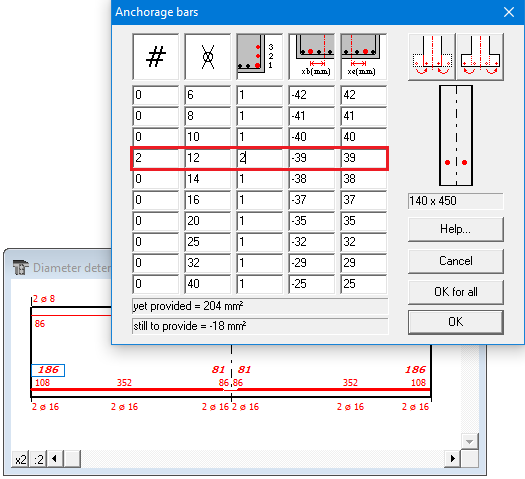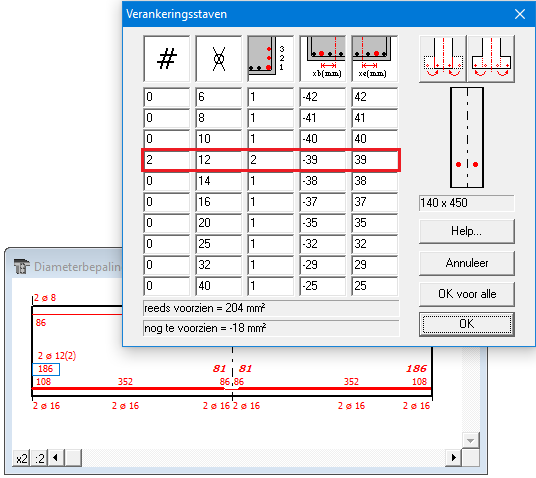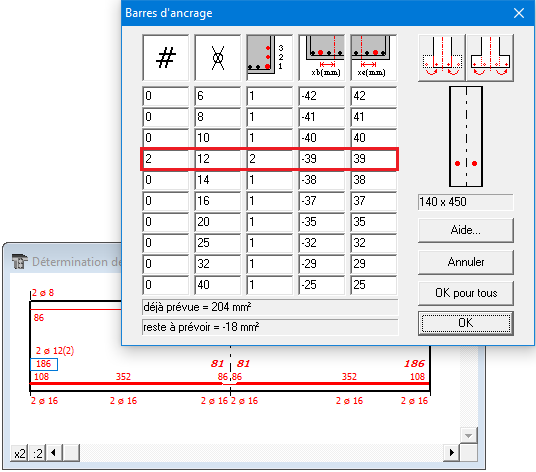It is often interesting for prefabrication purposes to keep the bottom reinforcement separate for each span. With prefabrication, however, a second difficulty occurs, namely nodes with a large number of protruding reinforcement bars are difficult and sometimes almost impossible to cast in place. A fitting solution to solve this problem is to keep the anchorage reinforcement as limited as possible by means of discontinuous anchorage.
This means that the foreseen bottom reinforcement of the different spans is nowhere within the dimensions of the column and that we place extra anchorage bars, mostly a little more centred in the cross section (nearer to the section axis) and possibly in the second layer, to avoid conflicts with other bars.
These anchorage bars are extended within the dimensions of the columns. They provide both anchoring in the columns and transfer to the actual bottom reinforcement. The required sections for these anchorage bars, the so-called anchorage sections, are indicated in the window “Diameter determination” ![]() there where the supports are located, just above the bottom reinforcement sections. We use the same workflow as described in this article, to transform these sections into bars.
there where the supports are located, just above the bottom reinforcement sections. We use the same workflow as described in this article, to transform these sections into bars.

Voor prefabricatie-doeleinden is het vaak interessant om de onderwapening per overspanning afzonderlijk te houden. Er evenwel nog een tweede moeilijkheid op, namelijk knopen met een groot aantal uitstekende wapeningsstaven moeilijk en soms haast onmogelijk op te gieten zijn. Een passende oplossing is de verankeringswapening zo beperkt mogelijk gehouden d.m.v. discontinue verankering.
Hiermee wordt bedoeld dat de voorziene onderwapening van de verschillende overspanningen nergens binnen de afmetingen van de kolommen vallen, en dat bijkomende verankeringsstaven geplaatst worden, meestal iets meer centraal in de doorsnede (kleinere afstanden tot de doorsnede-as) en eventueel in de tweede laag om geen conflicten te krijgen met andere staven.
Deze verankeringsstaven worden doorgetrokken binnen de afmetingen van de kolommen. Ze zorgen enerzijds voor de verankering in de kolom en anderzijds voor de overdracht naar de eigenlijke onderwapening. De benodigde secties voor deze verankeringsstaven, de zogenaamde verankeringssecties, staan in het venster “Diameterbepaling” ![]() ter plaatse van de steunpunten juist boven de onderwapeningssecties aangeduid. We gebruiken dezelfde werkwijze als in dit artikel om de theoretische secties om te zetten in een praktisch aantal staven.
ter plaatse van de steunpunten juist boven de onderwapeningssecties aangeduid. We gebruiken dezelfde werkwijze als in dit artikel om de theoretische secties om te zetten in een praktisch aantal staven.

Il est souvent intéressant, à des fins de préfabrication, de conserver une armature inférieure distincte par portée. Toutefois, la préfabrication entraîne une deuxième difficulté: la présence de nombreuses barres d’armature au droit des nœuds à couler complique souvent la coulée du nœud, voire la rendent pratiquement impossible. Pour remédier à ce problème, il convient de prévoir que l’armature d’ancrage soit réduite par le biais d’un ancrage discontinu.
Ceci suppose que l’armature inférieure prévue pour les différentes travées ne coïncide jamais avec les dimensions des colonnes et que des barres d’ancrage supplémentaires soient placées, éventuellement dans un deuxième lit, afin d’empêcher tout chevauchement avec d’autres barres.
Ces barres d’ancrage permettent d’une part, l’ancrage dans la colonne et d’autre part, la transmission des efforts vers l’armature inférieure. Les sections nécessaires de ces barres d’ancrage, communément appelées sections d’ancrage, sont indiquées dans la fenêtre “Détermination du diamètre” ![]() au droit des appuis, juste au-dessus des sections d’armature inférieure. Nous utilisons la même méthode que dans cet article pour convertir les sections théoriques en un nombre pratique de barres.
au droit des appuis, juste au-dessus des sections d’armature inférieure. Nous utilisons la même méthode que dans cet article pour convertir les sections théoriques en un nombre pratique de barres.


